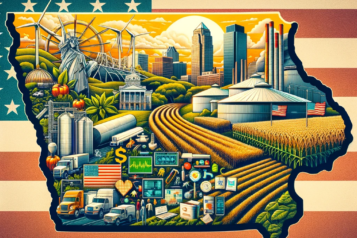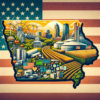In the vast, open fields of Iowa, a silent crisis is unfolding. The rural population, once the backbone of the state’s identity and economy, is in a persistent decline. Small towns that thrived on the spirit of community and agriculture are facing an exodus that threatens their very existence. This issue not only reshapes the demographic map of the state but also raises critical concerns about the future of Iowa’s rural heritage.
The Vanishing Heartland
Iowa, known for its rolling fields of corn and soybeans, has long been emblematic of American agrarian life. But the past few decades have seen a dramatic shift. Young people are leaving small towns for cities, drawn by the allure of greater opportunities and urban lifestyles. The numbers are stark: according to the U.S. Census Bureau, numerous counties in Iowa have seen double-digit percentage declines in population over the past decade.
Economic Shifts
The reasons behind this rural flight are multifaceted, but economic factors play a pivotal role. Advances in farming technology have led to more efficient agriculture practices, requiring fewer hands on deck. The jobs that remain are often low-paying, with little room for advancement, prompting the younger generation to seek careers elsewhere. Moreover, the consolidation of farms has reduced the number of family-owned plots, diminishing the need for a workforce that once sustained small communities.
The Impact on Communities
The impact of population decline in rural areas is profound. Schools are consolidating, local businesses are shuttering, and healthcare facilities are becoming scarce. This not only affects the quality of life for remaining residents but also makes these areas less attractive to potential newcomers, creating a cycle of decline.
Political Repercussions
Politically, the depopulation of rural Iowa reshapes the state’s influence. Rural areas, traditionally conservative strongholds, are losing representation. This demographic shift could have long-term implications for Iowa’s political landscape, particularly in its role as an early indicator in presidential elections.
Searching for Solutions
State and local leaders are scrambling to address this crisis. Initiatives to bolster rural economies include investment in broadband internet to connect remote areas, incentives for small businesses, and programs aimed at attracting and retaining young professionals. Some towns have even taken to offering land and tax breaks to entice new residents.
A Call to Action
The decline of Iowa’s rural population is more than a set of statistics; it’s a call to action for all Iowans to engage with the question of what their state will look like in the decades to come. It’s about preserving a way of life that has defined not just a state, but the nation.
As Iowa goes, so may go other states across the Midwest and the country. The challenge is significant, but the resolve of Iowans to adapt and overcome is a powerful force. With concerted effort and innovative thinking, the hope is to see the rural heartlands flourish once again, not just survive. The future of Iowa’s small towns hangs in the balance, and the time to act is now.














